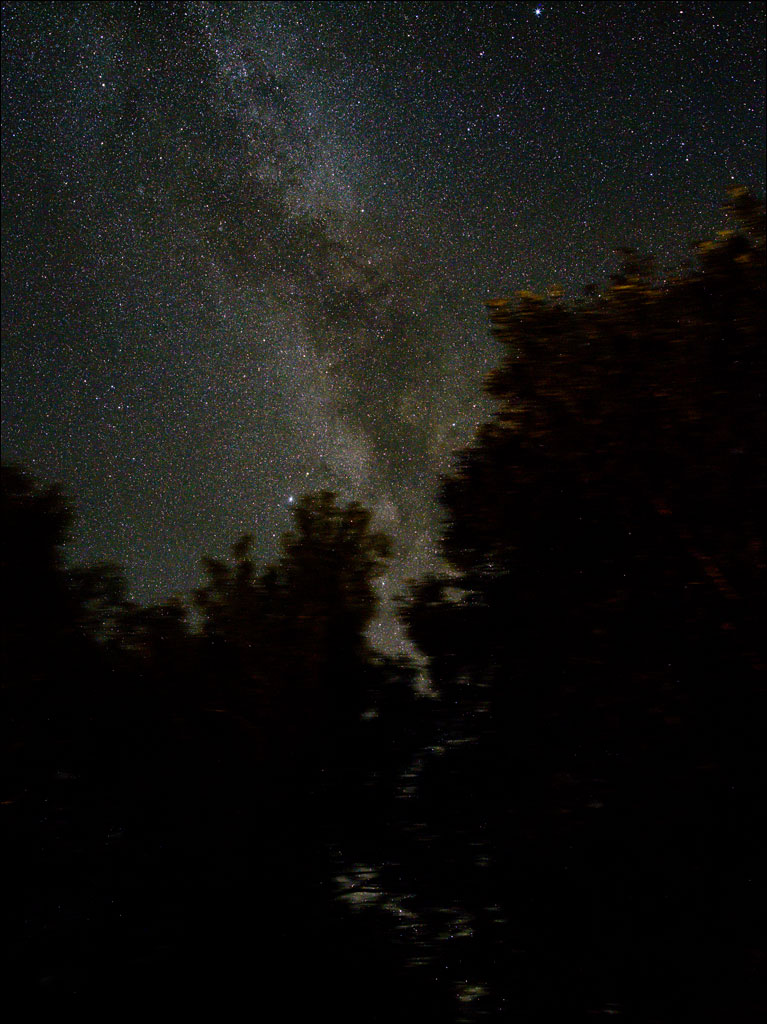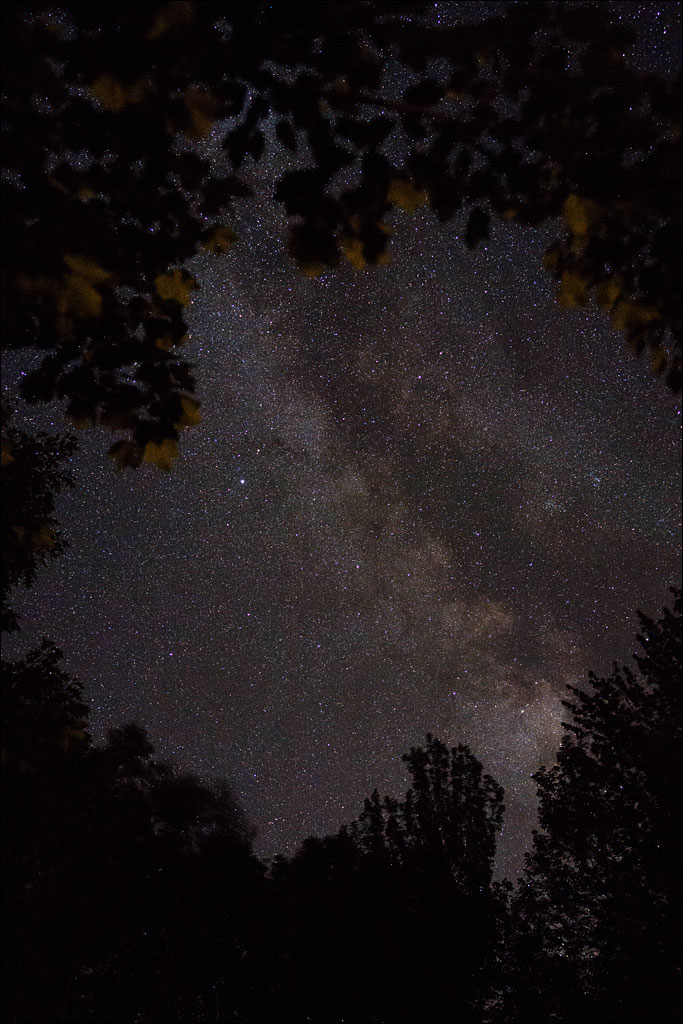The GetDPI Photography Forum
Great to see you here. Join our insightful photographic forum today and start tapping into a huge wealth of photographic knowledge. Completing our simple registration process will allow you to gain access to exclusive content, add your own topics and posts, share your work and connect with other members through your own private inbox! And don’t forget to say hi!
GFX and Milky Way Question
- Thread starter Greg Haag
- Start date
A fast lens of course helps keep exposure times short and ISO settings low. But given the flexibility of the 100 Mp BSI sensor, I think the shortcomings of the slower medium format lenses can be tolerated if not overcome. Below is an image I made several years ago with my 50 Mp Hasselblad X1D, shot wide open with the 3.5/30mm lens, 23s exposure at ISO 3200. I shot 10 images and performed a median blend on the sky and land portions separately before blending them back together again (the stars move, whereas the earth doesn't, at least from the perspective from terra firma). If you pixel peep you can make out short star trails that are otherwise not noticeable in an actual print. Shooting with a 23mm lens, these star trails would have been even less obvious, which gives you the latitude to either reduce the ISO or extend the exposure time.
In terms of focal length choices, from a compositional standpoint 23mm for me would be ideal. In another image from that same evening (here), I eeked out additional field of view through rotational shift and stitching (I would have shot with the XCD21 but alas, at that time it had not yet found its way into my kit). However for practical reasons this precluded image stacking so the result was a bit noisier. Also note that if you're going to tilt your camera up toward the sky, any buildings not at the center of the image will look oddly tilted.
Per @algrove above, you may be able to adapt the 19mm (Canon or Nikon?) but you should be aware of the lens's other characteristics like vignetting, coma and tendency toward chromatic aberration, which can really mess up an otherwise lovely composition.
Hope this helps.
John
 Milky Way, redux by John Ngai, on Flickr
Milky Way, redux by John Ngai, on Flickr
In terms of focal length choices, from a compositional standpoint 23mm for me would be ideal. In another image from that same evening (here), I eeked out additional field of view through rotational shift and stitching (I would have shot with the XCD21 but alas, at that time it had not yet found its way into my kit). However for practical reasons this precluded image stacking so the result was a bit noisier. Also note that if you're going to tilt your camera up toward the sky, any buildings not at the center of the image will look oddly tilted.
Per @algrove above, you may be able to adapt the 19mm (Canon or Nikon?) but you should be aware of the lens's other characteristics like vignetting, coma and tendency toward chromatic aberration, which can really mess up an otherwise lovely composition.
Hope this helps.
John
 Milky Way, redux by John Ngai, on Flickr
Milky Way, redux by John Ngai, on FlickrGreg- if you are not using a tracker, the rough formula for maximum time is 1/focal length. A bit less time if you are enlarging to a great extent. The biggest issue for lenses, regardless of the maker, is whether coma appears for stars on the corners of the image. I have not tried my 23mm on the GFX to comment on coma( coma will appear as a non-round star even on a tracker). Use your 23mm wide open- stopping down just reduces capture of the light. One bit of advice-focus on one of the bight stars early in the evening, then use a piece of tape to preserve infinity point. Most lenses focus beyond infinity so don’t just rack the lens out fully. you will have fun! Don
And if you really want critical focus you will want a good bahtinov filter . There are many suppliers- perhaps like this one. The grating is what makes critical star focus possible. https://bahtinovmask.com/products/kase-bright-star-professional-focus-mask-threaded-filter
BTW that formula is in seconds. A 23mm lens would allow you ~21 seconds of exposure. You may have to adjust the formula for the large sensor on the GFX but its a starting point. A good reference to lens defects during astrophotography is at https://www.lonelyspeck.com/a-pract...rations-and-the-lonely-speck-aberration-test/
Greg Haag
Well-known member
Don, thank you for your guidance, I really appreciate it!And if you really want critical focus you will want a good bahtinov filter . There are many suppliers- perhaps like this one. The grating is what makes critical star focus possible. https://bahtinovmask.com/products/kase-bright-star-professional-focus-mask-threaded-filter
Greg Haag
Well-known member
Thank you and thanks for the link as well, I will take a look at that!BTW that formula is in seconds. A 23mm lens would allow you ~21 seconds of exposure. You may have to adjust the formula for the large sensor on the GFX but its a starting point. A good reference to lens defects during astrophotography is at https://www.lonelyspeck.com/a-pract...rations-and-the-lonely-speck-aberration-test/
I’ve definitely chased after the “perfect” Astro setup for Milky Way shots (even to the extent of getting a D810A, which was pretty cool), but, at the end of the day, my experience has taught me that the best is whatever you have with you at the time. With the right conditions, things like f2.8 vf4 don’t really matter a ton for Milky Way shots IMHO.
Id just stick with the 23mm and have fun either single shot or using trackers or other tricks ppl have mentioned. @jng has my 21mm and it served me well on the X1D for Astro, well enough that I came to the conclusion it wasn’t worth getting a specialty lens or setup just for Milky Way shots and I stopped chasing that dragon.
either single shot or using trackers or other tricks ppl have mentioned. @jng has my 21mm and it served me well on the X1D for Astro, well enough that I came to the conclusion it wasn’t worth getting a specialty lens or setup just for Milky Way shots and I stopped chasing that dragon.
Id just stick with the 23mm and have fun
I think you're referring to the "500 rule?" Which is 500/focal length (in 35mm equivalents) to determine exposure time in seconds that will give "acceptable" star trails. So, for the equivalent of a 20mm lens this works out to 500/20 = 25s. YMMV, of course, so adjust up or down to taste. Once the shutter speed is set, then adjust ISO to get a reasonable exposure.Greg- if you are not using a tracker, the rough formula for maximum time is 1/focal length. A bit less time if you are enlarging to a great extent.
John
Most likely the nikon 19mmf4, either adapted or the remounted and rehoused cambo versionGreg
Someone makes a 19mm for the GFX. Can't remember who. Don Libby has one.
Ed Hurst
Well-known member
I have had success using Pentax 645 28-45mm and 25mm lenses (via an adaptor) on the GFX100S - not tracked, but stacking anywhere between 5 and 10 frames to manage noise. I find Sequator a good application for the stacking process (not immediately user-friendly, but effective once you get your head around it).
I've also just bought the Laowa 20mm f4 shift lens and have high hopes for it - but can't immediately report experience with it.
I've also just bought the Laowa 20mm f4 shift lens and have high hopes for it - but can't immediately report experience with it.
Ed Hurst
Well-known member
Might it be a Laowa lens, which I think does exist in GFX mount? (I have no experience of that one though!)Most likely the nikon 19mmf4, either adapted or the remounted and rehoused cambo version
Ed Hurst
Well-known member
For reference, here are some Milky Way pictures shot using 645Z without either tracking or stacking - all with the DA 25mm lens. The GFX100S would beat these from my experience thus far.
 Narrabri 3 by Ed Hurst, on Flickr
Narrabri 3 by Ed Hurst, on Flickr
 IMGP9607Step7SSsRGBSMALL-L by Ed Hurst, on Flickr
IMGP9607Step7SSsRGBSMALL-L by Ed Hurst, on Flickr
 PanoFromFilesIMGP5115-21And5368-73V7Step10FlatsRGBSMALL-L by Ed Hurst, on Flickr
PanoFromFilesIMGP5115-21And5368-73V7Step10FlatsRGBSMALL-L by Ed Hurst, on Flickr
 Milky Way rising over Palm Beach and Barrenjoey Head by Ed Hurst, on Flickr
Milky Way rising over Palm Beach and Barrenjoey Head by Ed Hurst, on Flickr
 _IMG3737Step3SSsRGBSMALL by Ed Hurst, on Flickr
_IMG3737Step3SSsRGBSMALL by Ed Hurst, on Flickr
 PanoFromFiles_EWR5251-59_Step10FlatsRGBSMALL by Ed Hurst, on Flickr
PanoFromFiles_EWR5251-59_Step10FlatsRGBSMALL by Ed Hurst, on Flickr
 Narrabri 3 by Ed Hurst, on Flickr
Narrabri 3 by Ed Hurst, on Flickr IMGP9607Step7SSsRGBSMALL-L by Ed Hurst, on Flickr
IMGP9607Step7SSsRGBSMALL-L by Ed Hurst, on Flickr PanoFromFilesIMGP5115-21And5368-73V7Step10FlatsRGBSMALL-L by Ed Hurst, on Flickr
PanoFromFilesIMGP5115-21And5368-73V7Step10FlatsRGBSMALL-L by Ed Hurst, on Flickr Milky Way rising over Palm Beach and Barrenjoey Head by Ed Hurst, on Flickr
Milky Way rising over Palm Beach and Barrenjoey Head by Ed Hurst, on Flickr _IMG3737Step3SSsRGBSMALL by Ed Hurst, on Flickr
_IMG3737Step3SSsRGBSMALL by Ed Hurst, on Flickr PanoFromFiles_EWR5251-59_Step10FlatsRGBSMALL by Ed Hurst, on Flickr
PanoFromFiles_EWR5251-59_Step10FlatsRGBSMALL by Ed Hurst, on FlickrEd Hurst
Well-known member
I also have one shot with GFX100S plus the Pentax 25mm lens, which I can't yet post here because it's for a specific purpose that requires it to be under wraps. But I can share it with you by direct message if you're interested. Just shoot me a note if so, and I'll share with you 
Greg Haag
Well-known member
Thanks Ed, I sent you a direct message. Thanks for all the help and btw great images. I think I may have been making this more complicated than it has to be.I also have one shot with GFX100S plus the Pentax 25mm lens, which I can't yet post here because it's for a specific purpose that requires it to be under wraps. But I can share it with you by direct message if you're interested. Just shoot me a note if so, and I'll share with you


